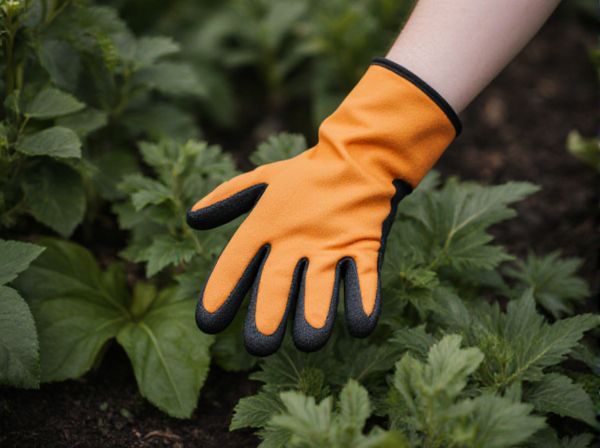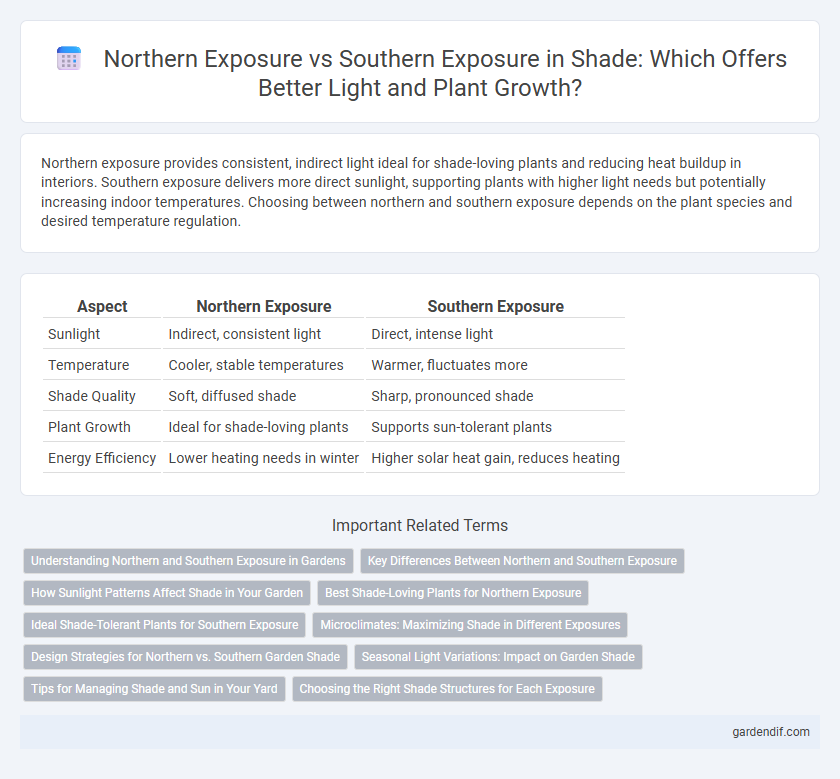
Northern exposure vs southern exposure Illustration
Northern exposure provides consistent, indirect light ideal for shade-loving plants and reducing heat buildup in interiors. Southern exposure delivers more direct sunlight, supporting plants with higher light needs but potentially increasing indoor temperatures. Choosing between northern and southern exposure depends on the plant species and desired temperature regulation.
Table of Comparison
| Aspect | Northern Exposure | Southern Exposure |
|---|---|---|
| Sunlight | Indirect, consistent light | Direct, intense light |
| Temperature | Cooler, stable temperatures | Warmer, fluctuates more |
| Shade Quality | Soft, diffused shade | Sharp, pronounced shade |
| Plant Growth | Ideal for shade-loving plants | Supports sun-tolerant plants |
| Energy Efficiency | Lower heating needs in winter | Higher solar heat gain, reduces heating |
Understanding Northern and Southern Exposure in Gardens
Northern exposure in gardens provides consistent, indirect sunlight ideal for shade-tolerant plants like ferns and hostas, promoting lush greenery without intense heat stress. Southern exposure receives abundant direct sunlight, supporting sun-loving species such as tomatoes and lavender while requiring strategies for shade during peak heat to prevent plant scorch. Understanding these light dynamics enables gardeners to optimize plant placement, enhancing growth and garden health by matching species to their ideal light conditions.
Key Differences Between Northern and Southern Exposure
Northern exposure provides consistent, indirect natural light ideal for growing shade-tolerant plants and maintaining cooler indoor temperatures, while southern exposure offers direct sunlight that supports sun-loving plants and warmer environments. The intensity and duration of light differ significantly, with southern-facing areas receiving more sunlight throughout the day, influencing plant growth and energy efficiency. Understanding these differences helps optimize landscaping, interior plant placement, and solar energy utilization based on specific light and temperature requirements.
How Sunlight Patterns Affect Shade in Your Garden
Northern exposure provides consistent, indirect sunlight throughout the day, creating cooler and more stable shaded areas ideal for shade-loving plants. Southern exposure receives intense, direct sunlight for most of the day, leading to dappled or partial shade during morning and late afternoon, which can influence plant growth and soil moisture. Understanding these sunlight patterns helps optimize garden design by selecting appropriate plants and positioning shade structures effectively.
Best Shade-Loving Plants for Northern Exposure
Northern exposure provides low, indirect light ideal for shade-loving plants such as ferns, hostas, and snake plants. These plants thrive in cooler, dimmer environments, utilizing minimal sunlight to maintain lush foliage. Selecting shade-tolerant species for northern-facing windows ensures healthy growth and vibrant indoor greenery.
Ideal Shade-Tolerant Plants for Southern Exposure
Southern exposure provides intense sunlight, making it challenging for many shade-tolerant plants to thrive. Ideal shade-tolerant plants for southern exposure include ferns like the Japanese Painted Fern and hostas, which possess resilience against strong light while maintaining lush foliage. Other suitable options are Caladiums and Heucheras, known for their vibrant colors and ability to withstand bright, indirect sun.
Microclimates: Maximizing Shade in Different Exposures
Northern exposure tends to create cooler microclimates with consistent, indirect shade that benefits shade-loving plants and reduces heat stress. Southern exposure, in contrast, generally offers more intense sunlight but can be strategically shaded using trees or structures to create microclimates that balance light and shade. Understanding these microclimate variations allows for optimal placement of shade-tolerant vegetation and improved energy efficiency in landscaping.
Design Strategies for Northern vs. Southern Garden Shade
Northern exposure gardens receive limited direct sunlight, making shade-tolerant plants like hostas and ferns ideal for these areas. Southern exposure gardens benefit from abundant sunlight and require design strategies that incorporate drought-resistant plants and strategic shading elements such as pergolas or deciduous trees to reduce heat stress. Selecting plant species based on light intensity and using structural shade solutions optimize growth and comfort in both northern and southern garden exposures.
Seasonal Light Variations: Impact on Garden Shade
Northern exposure provides consistent, indirect light throughout the year, creating stable shade areas ideal for shade-loving plants and cooler microclimates in gardens. Southern exposure experiences intense, direct sunlight during summer months with seasonal shifts that reduce light in winter, resulting in variable shade patterns that affect plant growth cycles and water needs. Understanding these seasonal light variations enables gardeners to optimize plant placement by matching species to specific shade conditions created by Northern and Southern exposures.
Tips for Managing Shade and Sun in Your Yard
Northern exposure typically results in more persistent shade, limiting direct sunlight and favoring shade-tolerant plants like ferns and hostas. Southern exposure provides abundant sun, ideal for sun-loving species but may require strategic shade solutions such as pergolas or shade cloth to prevent plant stress and soil drying. Managing shade and sun effectively involves selecting the right plants for each exposure and incorporating structures or landscaping elements to balance light distribution in your yard.
Choosing the Right Shade Structures for Each Exposure
Northern exposure typically receives consistent, indirect sunlight, making shade structures like pergolas or shade sails ideal for filtering light without blocking it entirely. Southern exposure demands robust shade solutions such as retractable awnings or solid canopy covers to protect against intense, direct sunlight and heat. Selecting the right materials, like UV-resistant fabrics and breathable mesh, enhances comfort and durability tailored to each directional challenge.
Northern exposure vs southern exposure Infographic

 gardendif.com
gardendif.com